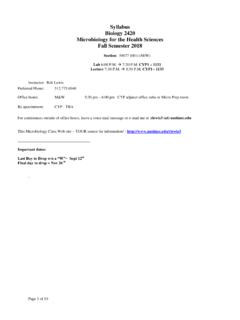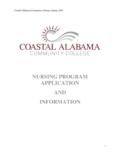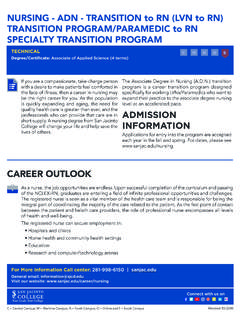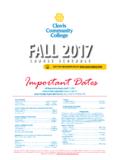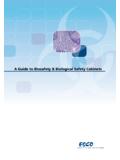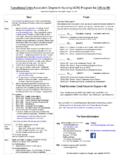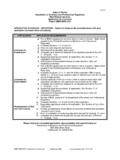Transcription of Quality assurance for microbiology in feed analysis ...
1 ManualISSN 1810-111916 FAO ANIMAL PRODUCTION AND HEALTHA nimal feeding influences every sector of the livestock industry. High Quality animal feed with the correct nutritional content and free from harmful contaminants, such as microbiological agents or their toxins, ensures that animals will be in the best possible condition, content and healthy. As a result animals will produce increased yields of Quality products (meat, milk, eggs or wool) resulting in improved health and wellbeing of the human population. This publication provides comprehensive guidance on the requirements of a microbiology laboratory performing animal feed analysis and includes examples of standard operating procedures, prepared by experts from around the world.
2 These procedures will assist laboratories in attaining the competence required, will enhance the Quality of data reported and ensure the safety of laboratory workers. The procedures contained in this publication are compliant with ISO/IEC 17025:2005 (General requirements for the competence of testing and calibration laboratories) and take into account ISO 14001:2004 (Environmental management systems) and BS OHSAS 18001:2007 (Occupational health and safety management systems) and will assist laboratories to gain accreditation or certification. This publication will be useful for laboratory analysts, laboratory managers, students and teachers and will enable workers in the livestock industry to appreciate the importance of proven reliable data and Quality assurance .
3 Implementing the procedures will strengthen the research and education capabilities of students and promote a better trading environment between developing and developed economies. This will have long-term benefits and promote investment in feed industries and R& assurance for microbiology in feed analysis laboratoriesQUALITY assurance FOR microbiology IN FEEDANALYSIS LABORATORIESC over photographs:Left: FAO/Assim HafeezMiddle: FAO/Jon SpaullRight: FAO/Ami VitaleFAO ANIMAL PRODUCTION AND HEALTHFOOD AND AGRICULTURE ORGANIZATION OF THE UNITED NATIONSRome, 201316manualQUALITY assurance FOR microbiology IN feed analysis LABORATORIESThe designations employed and the presentation of material in this information product do not imply the expression of any opinion whatsoever on the part of the Food and Agriculture Organization of the United Nations (FAO) concerning the legal or development status of any country, territory, city or area or of its authorities, or concerning the delimitation of its frontiers or boundaries.
4 The mention of specific companies or products of manufacturers, whether or not these have been patented, does not imply that these have been endorsed or recommended by FAO in preference to others of a similar nature that are not views expressed in this information product are those of the author(s) and do not necessarily reflect the views or policies of 978-92-5-107656-9 (print)E-ISBN 978-92-5-107657-6 (PDF) FAO 2013 FAO encourages the use, reproduction and dissemination of material in this information product. Except where otherwise indicated, material may be copied, downloaded and printed for private study, research and teaching purposes, or for use in non-commercial products or services, provided that appropriate acknowledgement of FAO as the source and copyright holder is given and that FAO s endorsement of users views, products or services is not implied in any requests for translation and adaptation rights, and for resale and other commercial use rights should be made via or addressed to information products are available on the FAO website ( ) and can be purchased through A.
5 CowieMIBMS FCQI CQPS enior Quality assurance ManagerSRUCF erguson BuildingCraibstone EstateAberdeenAB21 9 YAScotlandE-mail: MakkarAnimal Production OfficerAnimal Production and Health Division FAO, Rome, ItalyRecommended citationFAO. 2013. Quality assurance for microbiology in feed analysis laboratories, by Cowie. Edited by Harinder Makkar. FAO Animal Production and Health Manual No. 16. RomeiContentsForeword iiiAcknowledgements vPart 1 The Quality Management System in a microbiology laboratory 1 Introduction 3 Glossary of terms 5 Quality assurance purpose and guidelines 9 microbiology laboratory organization and responsibilities 11 Personnel training, qualification and competence in the microbiology laboratory 13accommodation (facilities)
6 And environment 15 microbiology testing selection and verification of methods (including measurement uncertainty) 19 Standard Operating Procedures (SOPs) 23 Equipment maintenance and service 25reporting microbiological results 31traceability of results 35 Proficiency testing 39 Documentation and control of documents 41 Health and safety (including risk assessment) in the microbiology laboratory 45audits, corrective actions and management review in the microbiology laboratory 55 Corrective and Preventive actions (CaPa) 63 Part 2 Quality assurance and general laboratory procedures 69 Microbiological media, reagents and chemicals 71receiving microbiological samples 77 Handling and preparation of microbiological samples 81 Microbiological identification using traditional and commercial methods 87 Gram stain and primary characterisation tests 91 Use of autoclaves 99iiUse of incubators and temperature controlled equipment 105 Basic microbiological techniques 109 Use of balances 115 Use of pipettors 119 Use of pH meters 123 microbiology laboratory water 125 microbiology laboratory glassware 127 Part 3 microbiology procedures 131 Introduction 133 Isolation and enumeration of Enterobacteriaceae from animal feed samples 135
7 Isolation and identification of Escherichia coli O157 from animal feed samples 139 Isolation of Salmonella spp. from animal feed samples 143 Isolation of Listeria spp. from animal feed samples 149 Isolation and enumeration of yeasts (excluding probiotic yeast), moulds, Dematiaceae and aerobic/mesophilic bacteria from animal feed samples 155 Isolation and enumeration of Aspergillus spp. from animal feed samples 161 Isolation and enumeration of probiotic bacteria and yeasts from animal feed samples 165 Isolation and enumeration of Sulphite reducing (Sr) Clostridia spp. from animal feed samples 171 Detection of Toxoplasma gondii in animal feed samples 175 Detection of Echinococcus spp. in animal feed samples 179 Detection of Trichinella spp.
8 In animal feed samples 183 Detection of Processed animal Protein (PaPs) in animal feed samples 187 List of reviewers of this document for FaO 195iiiForewordAnimal feeding impacts on many areas of agriculture: productivity, environmental emissions, water pollution, land use, animal health, product safety, product Quality and animal welfare. Every sector of the livestock industry, the associated services and the wellbeing of both animals and humans are influenced by animal feeding. Proper animal feeding is the supply of a diet balanced in all nutrients and free from contaminants and undesirable substances, at a level that meets the production objective (considering the animal s physiological state) and generates animal products that are safe for human consumption.
9 One of the most significant contaminants of animal feed are microbiological agents. The detection and enumeration of harmful bacteria, yeasts, fungi and parasites is imperative for the health of the animals and of the humans consuming animal products. A robust Quality Management System, within microbiology laboratories engaged in testing animal feed , is vital to guarantee that only reliable data is produced which ensures confidence in the micro-biological testing received from international experts visiting animal nutrition laboratories which are engaged in analysing feeds and feed ingredients in developing countries, highlight the need to strengthen Quality assurance systems in these laboratories. Without a robust Quality Management System in place, the microbiology laboratory personnel are unable to evaluate the Quality of the results being generated.
10 Various ring trials conducted in developed coun-tries have shown an unacceptable variation for some matrices being routinely determined in feed analysis laboratories. Similarly evidence received from the feed industries in developing countries on the reliability of feed analysis data suggests this is inconsistent. Therefore an urgent need to produce a document covering Quality assurance systems was realized. A previous document ( Quality assurance for Animal feed analysis Laboratories) was developed and prepared by a panel of nine experts. The emphasis was on the basic analysis used for determining the nutritional value of feeds and feed ingredients. The document gave a comprehensive account of good laboratory practices, Quality assurance procedures and examples of standard operating procedures as used in individual specialist laboratories.










